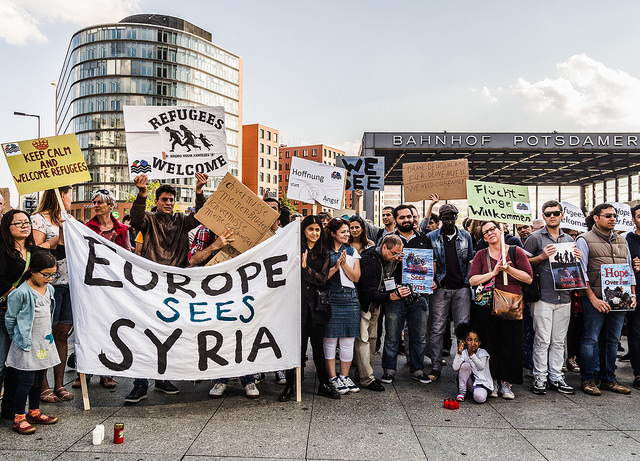clear
Are Syrian and Iraqi refugees similar?
clear

source:
ekvidi/flickr (CC BY-NC 2.0)
Syrian and Iraqi refugees comprise disparate religious and ethnic groups but the problems they face are universal - poverty, malnourishment, curtailment of education and employment, the all-pervasive threat of violence, and hostility from their adopted countries.
The Syrian crisis began in 2011. A confrontation between President Assad’s regime and its opponents degenerated into all-out war involving multiple armed factions, including Hezbollah, Al-Qaeda affiliates and Islamic State. Civilians have inevitably been caught in the middle of what is often a three-way confict between Assad's army and their militia allies, 'moderate rebels' and jihadists. 6.6 million Syrians have been displaced internally while 4.8 million have fled to Lebanon, Turkey, Jordan, Egypt and Iraq. Around a million Syrians have requested asylum in Europe.
Iraqis have been forced to flee on many occasions - the Iran-Iraq War (1980-88), the Gulf War (1991) and the US-led invasion of 2003 that toppled Saddam Hussein’s regime. Far from bringing stability after the ousting of its dictator, the collapse of the Iraqi state prompted sectarian strife between Sunnis, Shias and Kurds. Some 4 million Iraqis have fled this bloodshed. Ironically, Syria was once a haven for Iraqi refugees. In 2007 the United Nations High Commission for Refugees (UNHCR) estimated 1.2 million Iraqi refugees were living in Syria, the majority in the capital, Damascus.
The UNHCR has reported higher than average neuropsychiatric disorders among both Iraqi and Syrian refugees in transit camps, as well as increased instances of strokes, multiple sclerosis, epilepsy, and schizophrenia. The main thing displaced Iraqis and Syrians have in common is that there is little evidence of an end to the unrest that will allow them to return home.
 2
2
clear
As a whole, all refugees face similar challenges. However, even within the group of refugees of one nationality there will be people who come from very different backgrounds - differing levels of education, different economic circumstances and different classes. Not all of the refugees form either place found themselves in refugee camps. I have some friends who were refugees from the former Yugoslavia. They see themselves and their circumstances as very different to the current refugees from Syria and do not empathise with them much. I imagine Iraqi refugees might feel like that too. Just because two groups are a facing similar situation doesn’t make them “the same”.
 0
0
clear
Attacking Syria is not the same as invading Iraq, we are told. And of course, that's right. First, there's no doubt this time about the presence of chemical weapons. We're not
But these differences - which loom so large in the minds of Washington's political elites - seem entirely secondary to most of the rest of the world, even most of the people of the United States, following more than a decade of war, post-9/11. There are two things that attacking Syria and invading Iraq have in common, which US elites utterly ignore. First is the sheer frequency with which the US attacks other countries. Second is the casual disregard for dire and deadly negative consequences, so long as US elites convince themselves their motives are pure.
I want to list below 4 Syrians refugees facts:
1.One in six Syrians has been displaced from their homes.
 0
0
clear
 Wafa Benizid
6 years, 11 months ago
Wafa Benizid
6 years, 11 months ago

Sign up to post or vote on answers.
Improveo will help systemize your knowledge.